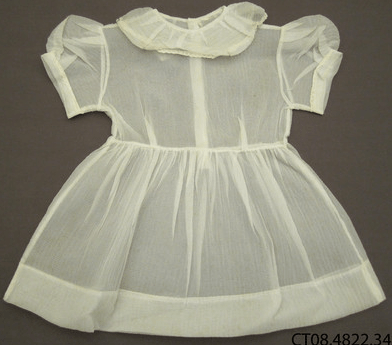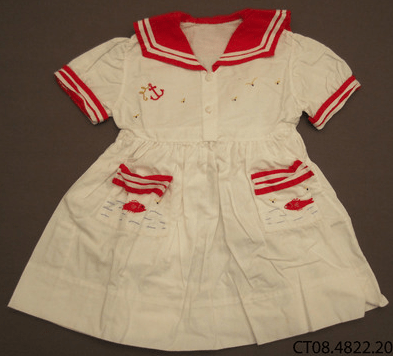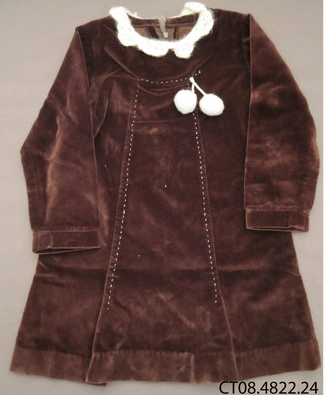
The Jones family baby and toddler clothes in the Owaka Museum collection date to the 1950s and 60s and were worn by three daughters, Pamela, Zelda and Vicki. A number of little white and pink dresses and petticoats were for their Sunday best, though any outing qualified. Mother Dawn Jones said they didn’t go out much, since groceries were delivered once a week, she didn’t drive and on a farm they had their own meat.
Outings included occasional trips to Balclutha and more often, though still not frequently, to Owaka. “It was a treat to go out, to come to Owaka from where we lived and you dressed up.” (Owaka is two kilometres from where they lived on the family farm and where daughter Vicki lives now.) Dawn said they went to church occasionally, to Plunket Day in Owaka (where it cost a penny to go to the toilet in the back), to Thursday sale day, and to the flower show. Sale Day was when cattle and sheep were sold, but people still dressed up for that, and the women and children had a day’s shopping and socialising.

Many of the girls’ dresses were bought at McNoe’s Baby Shop on Clyde Street, the main street of Balclutha. It was a ‘wee long narrow shop, loaded with clothes,. They were hooked onto the wall. A husband and wife ran it.” A petticoat in the collection was made by Bonwear of New Zealand. Two of her girls were wearing pink frilly dresses with little white straw hats to the pharmacy one day. The chemist called to his wife, “Bernice! Bernice! Come and look at these.”
Another one bought at McNoe’s was the first good dress bought for her eldest daughter, Pamela, when Dawn finally came home from the hospital after five weeks suffering from high blood pressure and toxaemia. “We stopped on the way home and bought it.” It was made in New Zealand for My Fair Baby, Junior House, and was a size 16. It was a warmer weight Viyella material, white with blue and pink embroidery and looked beautiful when worn.
A hand-made dress with a pink under-slip of lawn or poplin attached at the waist and with embroidered lace edging was not made by Dawn. The outer layer has a lacy look on white broderie anglaise with tiny rosebuds embroidered on it. It was worn by Vicki and by Dawn’s granddaughters.

One unusually coloured dress was a brown velvet one with a white collar embroidered by the late Mrs Effie Harrison, of Owaka. It has two little cotton balls tied on by a thin white rope of wool.
Dawn made a layette set for each of her girls. They are all in the collection, and the first two were two-ply. “It took me ages to knit them.” There was a frock, jacket, bootees and bonnet for each set, though not all still have the bootees. They were white (though now look cream) and embroidered with pink rosebuds. The crocheted edgings were done by Dawn’s mother Selina Morris. “She didn’t teach any of us to crochet and I still can’t.” Another jacket was knitted for each child and grandchild but Dawn lost the pattern and couldn’t use it for her great-grandchild. The rosebuds were pink for the girls and blue for the boys and added at the end.
“My grandmother taught me to knit when I was seven. She was a hard taskmaster, but my friend (and later bridesmaid) had learnt to knit when she was four, and when Granny was outside gathering things like cabbage tree leaves, prunings, and chipped wood for kindling or strips of material to wind round them, she would do a couple of rows for me. Granny would say, “Those are a lovely couple of rows. What went wrong later here?” Our lips were sealed.”
Washing the layette and woollens was a mission. “I put down layers of newspaper on the bare floor, then two or three big bath towels, then laid out the wool and patted it into shape. Then I reversed it, putting the towels on top of the woollen bits, then newspaper again, then a mat on top, and we would walk over it to absorb the moisture.”
-Carolyn Deverson
Researcher & Secretary
Catlins Historical Society
